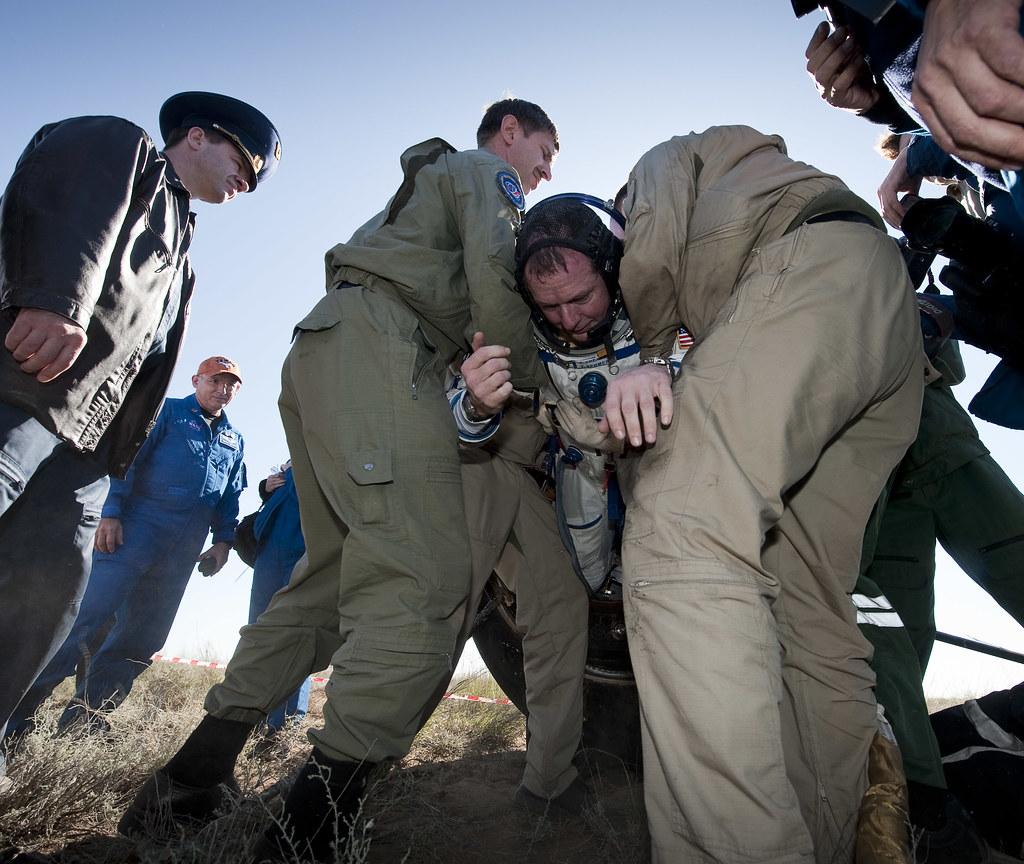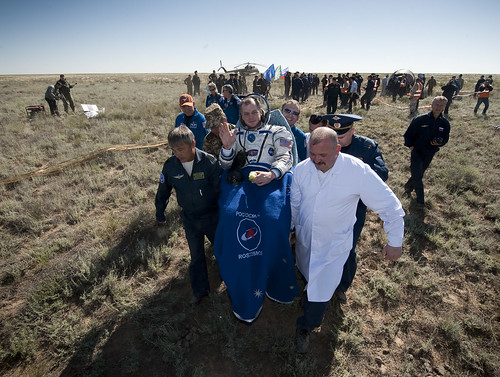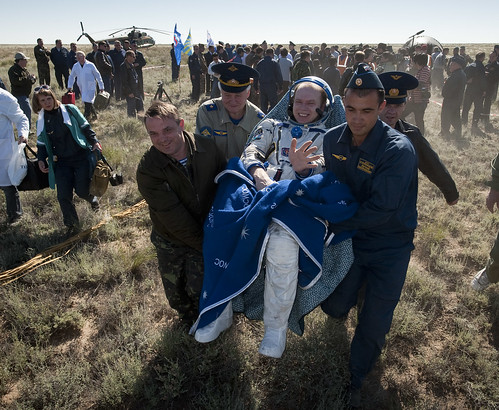- Joined
- Aug 5, 2008
- Messages
- 4,264
- Reaction score
- 0
- Points
- 0
Hatches will be opened at 12:40 PM EDT/4:40 PM GMT.
---------- Post added at 03:03 PM ---------- Previous post was at 02:56 PM ----------
Hooks are now closed.
That's it! Great job, Oleg! :thumbup:
---------- Post added at 07:43 PM ---------- Previous post was at 03:03 PM ----------
NASA TV video about the relocation:
[nomedia="http://www.youtube.com/watch?v=-4xBVuxxiFM"]YouTube- Crew Grabs New Parking Spot in Space[/nomedia]
---------- Post added at 10:51 PM ---------- Previous post was at 07:43 PM ----------
Full docking video.
---------- Post added 13th May 2010 at 07:54 PM ---------- Previous post was 12th May 2010 at 10:51 PM ----------
From ISS Daily Report for 12/05/2010:
Soyuz TMA-17/21S relocation went smoothly, freeing up the FGB Nadir port for the installation of MRM-1 during the upcoming STS-132/ULF-4 mission. After a brief ride in their crew return vehicle, CDR Kotov, FE-5 Noguchi & FE-6 Creamer docked at the SM Aft port, completing the spacecraft’s relocation in about 27 minutes. [After undocking, Soyuz CDR Oleg Kotov backed away from the station 25-30 m at ~0.12 m/s, then translated the spacecraft to the left, slewing sidewise through 90 deg along the ISS toward the aft end before rotating (“indexing”) the Soyuz around its longitudinal axis to align its periscope with the docking target on the SM, spending a short time in station-keeping mode. Final approach was then initiated, with docking occurring smoothly. After hooks and latches were engaged, the crew conducted leak checks, opened hatches, and then re-entered the station through the SM.]
Inside TMA-17, after hatch closure the three crewmembers donned their Sokol pressure suits and performed Soyuz checkout operations.
Next, Oleg, Soichi & Timothy conducted the standard fit check of the Kazbek couches, the contoured shock absorbing seats in the Soyuz Descent Module. [For the fit check, crew members removed their cabin suits and donned Sokol KV-2 suit and comm caps, getting into in their seats and assessing the degree of comfort and uniform body support provided by the seat liner. Using a ruler, they then measured the gap between the top of the head and the top edge of the seat liner facing the head crown. The results were reported to TsUP. Kazbek-UM couches are designed to withstand g-loads during launch and orbital insertion as well as during reentry and brake-rocket-assisted landing. Each seat has two positions: cocked (armed) and noncocked. In cocked position, they are raised to allow the shock absorbers to function during touchdown. The fit check assures that the crewmembers, whose bodies gain in length during longer-term stay in zero-G, will still be adequately protected by the seat liners for their touchdown in Kazakhstan, either emergency or regular return.]
RS thrusters were disabled for the FGB QD (Quick Disconnect, Russian: BZV) screw clamps removal and hook opening.
For the relocation, ISS attitude control authority was handed over to RS MCS (Motion Control System). After relocation, control returned to US Momentum Management.
After Soyuz re-docking, the crew completed the standard 1-hr Soyuz/SM AO (Assembly Compartment) leak checking and Sokol suit & glove drying.
RS thrusters were again inhibited for leak checking, hatch opening and post-docking clamp installation. TMA-17 deactivation then began, completing with the transition of TMA-17 to ISS/combined power.
---------- Post added at 03:03 PM ---------- Previous post was at 02:56 PM ----------
Hooks are now closed.
That's it! Great job, Oleg! :thumbup:
---------- Post added at 07:43 PM ---------- Previous post was at 03:03 PM ----------
NASA TV video about the relocation:
[nomedia="http://www.youtube.com/watch?v=-4xBVuxxiFM"]YouTube- Crew Grabs New Parking Spot in Space[/nomedia]
---------- Post added at 10:51 PM ---------- Previous post was at 07:43 PM ----------
Full docking video.
---------- Post added 13th May 2010 at 07:54 PM ---------- Previous post was 12th May 2010 at 10:51 PM ----------
From ISS Daily Report for 12/05/2010:
Soyuz TMA-17/21S relocation went smoothly, freeing up the FGB Nadir port for the installation of MRM-1 during the upcoming STS-132/ULF-4 mission. After a brief ride in their crew return vehicle, CDR Kotov, FE-5 Noguchi & FE-6 Creamer docked at the SM Aft port, completing the spacecraft’s relocation in about 27 minutes. [After undocking, Soyuz CDR Oleg Kotov backed away from the station 25-30 m at ~0.12 m/s, then translated the spacecraft to the left, slewing sidewise through 90 deg along the ISS toward the aft end before rotating (“indexing”) the Soyuz around its longitudinal axis to align its periscope with the docking target on the SM, spending a short time in station-keeping mode. Final approach was then initiated, with docking occurring smoothly. After hooks and latches were engaged, the crew conducted leak checks, opened hatches, and then re-entered the station through the SM.]
Inside TMA-17, after hatch closure the three crewmembers donned their Sokol pressure suits and performed Soyuz checkout operations.
Next, Oleg, Soichi & Timothy conducted the standard fit check of the Kazbek couches, the contoured shock absorbing seats in the Soyuz Descent Module. [For the fit check, crew members removed their cabin suits and donned Sokol KV-2 suit and comm caps, getting into in their seats and assessing the degree of comfort and uniform body support provided by the seat liner. Using a ruler, they then measured the gap between the top of the head and the top edge of the seat liner facing the head crown. The results were reported to TsUP. Kazbek-UM couches are designed to withstand g-loads during launch and orbital insertion as well as during reentry and brake-rocket-assisted landing. Each seat has two positions: cocked (armed) and noncocked. In cocked position, they are raised to allow the shock absorbers to function during touchdown. The fit check assures that the crewmembers, whose bodies gain in length during longer-term stay in zero-G, will still be adequately protected by the seat liners for their touchdown in Kazakhstan, either emergency or regular return.]
RS thrusters were disabled for the FGB QD (Quick Disconnect, Russian: BZV) screw clamps removal and hook opening.
For the relocation, ISS attitude control authority was handed over to RS MCS (Motion Control System). After relocation, control returned to US Momentum Management.
After Soyuz re-docking, the crew completed the standard 1-hr Soyuz/SM AO (Assembly Compartment) leak checking and Sokol suit & glove drying.
RS thrusters were again inhibited for leak checking, hatch opening and post-docking clamp installation. TMA-17 deactivation then began, completing with the transition of TMA-17 to ISS/combined power.






































